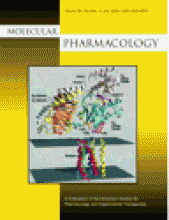Abstract
The molecular mechanisms of interaction between Gs and the A2A adenosine receptor were investigated using synthetic peptides corresponding to various segments of the Gαs carboxyl terminus. Synthetic peptides were tested for their ability to modulate binding of a selective radiolabeled agonist, [3H]2-[4-(2-carboxyethyl)phenylethylamino]-5′-N-ethylcarboxamidoadenosine ([3H]CGS21680), to A2A adenosine receptors in rat striatal membranes. The Gαs peptides stimulated specific binding both in the presence and absence of 100 μM guanosine-5′-O-(3-thiotriphosphate) (GTPγS). Three peptides, Gαs(378–394)C379A, Gαs(376–394)C379A, and Gαs(374–394)C379A, were the most effective. In the presence of GTPγS, peptide Gαs(374–394)C379A increased specific binding in a dose-dependent fashion. However, the peptide did not stabilize the high-affinity state of the A2A adenosine receptor for [3H]CGS21680. Binding assays with a radiolabeled selective antagonist, [3H]5-amino-7-(2-phenylethyl)-2-(2-furyl)pyrazolo[4,3-e]-1,2,4-triazolo[1,5-c]pyrimidine ([3H]SCH58261), showed that the addition of the Gαs peptide modified the slope of the 5′-N-ethylcarboxamidoadenosine (NECA) competition curve, suggesting modulation of receptor affinity states. In the presence of GTPγS, the displacement curve was right-shifted, whereas the addition of Gαs(374–394)C379A caused a partial left-shift. Both curves were fitted by one-site models. This same Gαs peptide was also able to disrupt Gs-coupled signal transduction as indicated by inhibition of the A2A receptor-stimulated adenylyl cyclase activity without affecting either basal or forskolin-stimulated enzymatic activity in the same membrane preparations. Shorter peptides from Gαs and Gαi1/2 carboxyl termini were not effective. NMR spectroscopy showed the strong propensity of peptide Gαs(374–394)C379A to assume a compact carboxyl-terminal α-helical conformation in solution. Overall, our results point out the conformation requirement of Gαscarboxyl-terminal peptides to modulate agonist binding to rat A2A adenosine receptors and disrupt signal transduction.
Footnotes
- Received November 23, 1999.
- Accepted March 13, 2000.
-
Maria R. Mazzoni, Dipartimento di Psichiatria, Neurobiologia, Farmacologia e Biotecnologie, Sezione di Neurobiologia e Farmacologia, Via Bonanno 6, 56126, Pisa, Italy. E-mail: mariarm{at}farm.unipi.it
-
This work was supported by a Human Capital and Mobility Grant (CHRX-CT94-0689) from the European Community (to M.R.M.) and by Ministero dell'Universitá e della Ricerca Scientifica e Tecnologica grants.
- The American Society for Pharmacology and Experimental Therapeutics
MolPharm articles become freely available 12 months after publication, and remain freely available for 5 years.Non-open access articles that fall outside this five year window are available only to institutional subscribers and current ASPET members, or through the article purchase feature at the bottom of the page.
|






